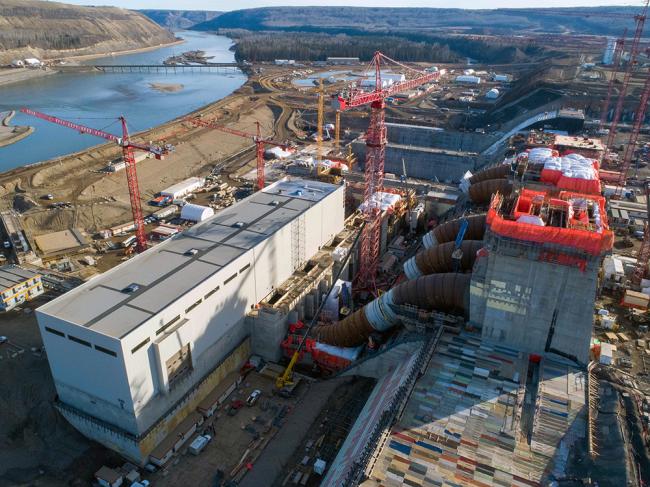Articles Menu

Construction is continuing on the Site C dam despite the Northern Health Authority declaring a COVID-19 outbreak among people working on the project.
“The declaration follows evidence of COVID-19 transmission among employees working primarily on civil works and excavation for the project,” the authority announced Thursday.
Northern Health said 34 people have tested positive at the site in five separate clusters of COVID-19 cases.
“Employees are being screened, and contact tracing is continuing,” it said. “Those identified as cases and close contacts have been instructed to self-isolate, either at their worksite accommodations, or in their home communities.”
The health authority is working with BC Hydro and its contractors on various steps to limit transmission, but said it isn’t ordering work to stop on the project.
“At this time, medical health officers have determined there is no need for closure orders for the overall project, or individual project worksites,” it said.
In a separate announcement, BC Hydro said there have been more than 40 cases of COVID-19 reported at Site C since the start of March and that in recent weeks the number of cases has increased. There are now 13 active cases and 100 workers isolating at home or on site.
In total, 93 people working on the project have tested positive for the virus since the pandemic started, according to BC Hydro’s website.
The announcement quoted BC Hydro president and CEO Chris O’Riley saying the “comprehensive plan” to avoid the spread of COVID-19 at the project introduced over the last year includes following health guidelines, daily screening of everyone arriving at the site, scanning people’s temperature when they arrive or leave, and increasing cleaning and physical distancing.
“The declaration of the outbreak demonstrates that we need to do better, and we will,” he said. “In addition to the steps we are already taking, we will look to implement further measures in the coming days.”
In other parts of the province, many businesses have been closed due to COVID-19 outbreaks, including nearly 50 in Fraser Health.
Provincial health officer Dr. Bonnie Henry has said that in workplaces where at least three people have COVID-19 and there is likely transmission on site, they will be ordered closed unless it’s in the public interest to keep it open.
During Henry’s media availability on Thursday, The Tyee wasn’t called on to ask a question and nobody else raised the topic.
Premier John Horgan and the B.C. government have been under pressure to introduce paid leave so that people can stay home when they are sick, something he says is coming soon.
BC Liberal Party interim leader Shirley Bond, the MLA for Prince George-Valemount, said any paid sick leave program should be provincially funded and not add expenses for employers.
“It is time the premier delivers on this promise, and we will certainly look forward to debating the details with him,” she said.
Transmission at Site C is a concern as it is with other workplaces where large numbers of people work closely together, Bond said.
“The government has certainly identified that industrial locations are a priority,” she said. “I’m not aware of the specific details today related to Site C, but I do think it is important that we look at where clusters occur, how we deal with that in the most effective way possible.”
In December, Henry issued an order restricting numbers at work camps for employees returning after the holidays. The order initially restricted numbers at the Site C work camp to 400, allowing for an incremental increase to 1,100 by the end of January.
The increases were based on a restart plan, approved by the public health officer, setting out how the increase in numbers would be managed to reduce the risk of spreading COVID-19.
On April 13, the initial order was replaced with a new order that focused on workforce monitoring and reporting worker numbers. It does not restrict camp numbers.
David Conway, community relations manager for Site C, said BC Hydro has been working closely with health officials throughout 2021 as the number of workers on the project increases.
“We have been fully compliant with the provincial health officer’s order as it has evolved since the new year,” he said. “The Industrial Camps Order no longer has prescribed limits on the number of workers permitted in camp. However, we continue to operate below the previously established limit of 2,153 workers on site at any given time and have not exceeded 1,800 workers on site since Jan. 1, 2021.”
He said 1,479 workers were in camp Thursday. The figure doesn’t include Site C’s local workforce, which is approximately 450 workers daily, or people working on off-dam site activities, he said.
The outbreak declaration will be in place at Site C for at least 28 days. Although there have been outbreaks at several work camps in the North, this is the first for Site C.
The third of a series of dams on the Peace River, Site C would flood an 83-kilometre-long stretch of the river to generate enough electricity to power 450,000 homes.
In February, the provincial government announced that completion of the project has been delayed until 2025, in part due to the COVID-19 pandemic, and the estimated cost had doubled to $16 billion from its original budget.
[Top photo: More than 40 cases of COVID-19 have been reported at the Site C dam site since the start of March, and the number of cases has increased in recent weeks, says BC Hydro. Photo via BC Hydro.]